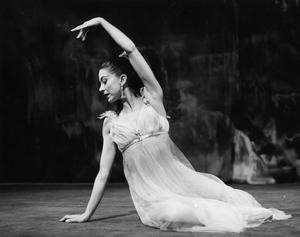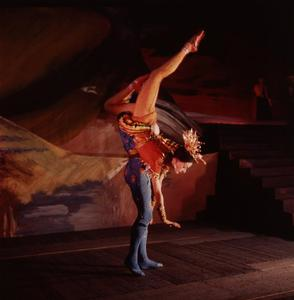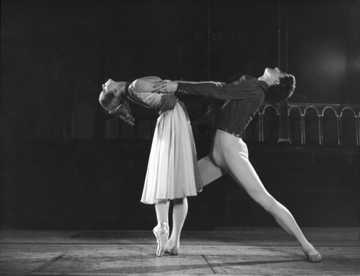Sir Frederick Ashton, Britain's unrivalled genius at creating ballets, had a simple attitude towards posterity. "You've heard his famous remark, 'Fuck posterity'?" says his nephew, Anthony Russell-Roberts, smiling but eyeing me apprehensively.
Ashton's attitude to posterity has not at all pleased a hefty section of his admirers who, since his death in 1988, have consistently accused Russell-Roberts and the Royal Ballet (where he is administrative director) of neglecting Ashton's work. People for whom Ashton was, as the critic P W Manchester remarked, "our youth, and our growing up, and our growing older" have argued that in the past decade the Royal Ballet has not only failed to research and record his ballets, but has performed too few, and those too apathetically - to the point where significant works of the past are now irrecoverable.
 Yesterday the Royal Ballet opened a revival of one of Ashton's least-seen works, Ondine, created in 1958 for Margot Fonteyn (pictured, in the role), and indelibly associated with her. It is a portrait of a nymph who breaks out of her watery milieu to love a mortal. Some people would say that Ondine is not performable today: (a) it was Fonteyn's and no one else's, and (b) it is dreadfully dated.
Yesterday the Royal Ballet opened a revival of one of Ashton's least-seen works, Ondine, created in 1958 for Margot Fonteyn (pictured, in the role), and indelibly associated with her. It is a portrait of a nymph who breaks out of her watery milieu to love a mortal. Some people would say that Ondine is not performable today: (a) it was Fonteyn's and no one else's, and (b) it is dreadfully dated.
They might say the same about Marguerite and Armand, which Ashton made exclusively for Fonteyn and Nureyev, and which the RB is attempting to recreate next spring for today's star ballerina Sylvie Guillem.
Some would say that we should remember and celebrate Ashton by the classics that most people agree about: Cinderella, Symphonic Variations and The Dream, La Fille mal gardée and The Two Pigeons. Odd bird, Ashton, they would point out, waving the revealing 1996 biography by Julie Kavanagh, Secret Muses. His humour and his taste are, like Noël Coward's, significant of his era but they don't wear well. And besides, much of his work is irretrievably lost. Because there is no record.
When Ashton died in 1988, aged 84, he had created 150 works of dance from 1926 onwards. His oeuvre, the core and backbone of first Ballet Rambert, then the Sadler's Wells companies that became the Royal Ballet, suffered a decline from the repertory under his successors as director of the company - Kenneth MacMillan, Norman Morrice and Anthony Dowell. In the 29 years since he was forcibly retired as director, his performed oeuvre has shrunk like a cashmere top in the hot cycle of the Zanussi.
The danger is that subjective values of today are destroying the potential for rediscovery in the future when tastes change
Ashton's work ranged enormously in scale, from instant gala numbers to dances for musicals and films, to new sections for the 19th-century classics, to the original one-act and three-act ballets. Not everything was a Hamlet, but he was not a man for big issues or deep psychoses: as with Mozart, "the more trivial the subject, the deeper and more beautiful is Ashton's view of it," critic Edwin Denby remarked.
Of the 150 only 24 could be called "in service". Some of these 24 have hardly been performed, if at all, in a decades. In sum, as things stand, in a generation or two, barely a tenth of the output of the Englishman who was the Shakespeare and Mozart of 20th-century ballet will be available for posterity to see. Posterity has been well and truly fucked.
How much should we worry? Given the profound beauties and amusements of the Ashtons we know, should we be struggling with might and main to rescue any others - practically to force old dancers into the studio, if necessary, to hear the music and try to re-envisage what they wore, where they stood, what they danced, while a notator busily scribbles down the guesses, and eventually tries to link them up into some partial semblance of the ballet that critics once acclaimed?
In America, by telling contrast, academics take an almost pedantic interest in stocking their archival cupboards. The American ballet genius, the late George Balanchine, has a Foundation of trustees who watch over his ballets as fiercely as a guard-dog, barking and scaring off any companies that do not satisfy their standards - including, sadly, the Royal Ballet two years ago, in a row that led to them cancelling performances of Apollo.
Choreographers Jerome Robbins and Antony Tudor also have trusts. Kenneth MacMillan's ballets are protected and promulgated by his widow, Deborah. The least juvenilia by today's greenest RB choreographer are recorded more permanently than the bulk of the work of the one unarguable ballet genius that Britain gave to the world.
A huge project in New York is now attempting to video and notate - or write down the steps of - all the 400-plus Balanchine ballets that can be dug out of notes, film or dancers' memories. Thus ballets unloved today have a chance of being loved again one day.
Russell-Roberts says that to do the same for Ashton's work would be a very different proposition. Twenty years of Ashton's work were mostly lost thanks to the Second World War. Also the Americans, he says, filmed Balanchine's ballets systematically from early on, and they are easily notated. Very few of Ashton's ballets were filmed; and only 51 of them are notated.
But even then, he admits, several of the notated ballets are still not reconstructable, because of serious flaws in the records.
"We have spent an awful lot of time trying vainly to recover Homage to the Queen," he says, adding to the hopeless pile Picnic at Tintagel, Dante Sonata ("This was the marvellous one," said Ninette de Valois), Foyer de danse (for Alicia Markova, inspired by Degas paintings), and, maybe the biggest loss, the three-act Sylvia of 1952, another Fonteyn vehicle.
 "There may possibly be fragments still to be found out there, but I don't think we're talking about whole Ashton ballets being recoverable. A lot of damage went on due to his own rather indolent temperament. When I was in short trousers I remember going to Rinaldo and Armida and Madame Chrysanthème, and it seems very strange to me that they can't now be revived. Perséphone I have very strong memories of - it was chilling, wonderful stuff, but we talked with Sylvie Guillem about attempting a revival and in the end decided it just wasn't possible."
"There may possibly be fragments still to be found out there, but I don't think we're talking about whole Ashton ballets being recoverable. A lot of damage went on due to his own rather indolent temperament. When I was in short trousers I remember going to Rinaldo and Armida and Madame Chrysanthème, and it seems very strange to me that they can't now be revived. Perséphone I have very strong memories of - it was chilling, wonderful stuff, but we talked with Sylvie Guillem about attempting a revival and in the end decided it just wasn't possible."
La Péri, he says - an oriental showpiece for Fonteyn - was definitely filmed illicitly by a member of the audience on a Russian tour in 1960 but they can't track down the filmer (pictured left, Fonteyn and Somes in 1956 in Ashton's La Péri, © Roger Wood/ROHCollections). Little old ladies with large hatpins used to be a bugbear, suspected of having microphones and cameras concealed; now it might be a blessing in certain cases, he says, if they would come forward with their pirate films.
That surreal hope is all that is left for the salvation of Mephisto Valse, Rio Grande, Harlequin in the Street, The Wanderer, The Quest, The Wise Virgins, Tiresias. The blindingly effective solo Ashton made for the 23-year-old Rudolf Nureyev's first performance in London in 1961, Poème Tragique, is gone; so are most of his Fonteyn display solos and duets.
The unluckiest recipient in Ashton's will was Margot Fonteyn, whose legacies Ondine and Daphnis and Chloe are rareties, performed only occasionally
The second major obstacle described by Russell-Roberts is money. A research project would be costly and have a very small likelihood of success. Though the National Lottery might be thought an obvious place to apply, Russell-Roberts claimed that, after its great generosity to the Royal Opera House, it would be unlikely to help the Royal Ballet again.
There is a further complicating factor. In a evident conflict of interest, the primary financial beneficiary of any successful restaging would be Russell-Roberts himself. Ashton, in his substantial will, left 12 major ballets to six friends and lovers, and all the rest to his sister Edith's son.
The earning power of these ballets varies enormously. Russell-Roberts would not tell me what royalties the RB pays for rights, but for another company to buy performing rights for a one-act ballet for three years costs £10,000-25,000; a three-acter is much more expensive; a gala snippet is around £1,000. These costs, he said, are comparable with Balanchine and MacMillan, though less than for one or two of today's living choreographers. The staging costs again can be enormous: £250,000 or more to mount a three-acter.
The popularity of the ballets also varies, partly because of the energy of their owners in encouraging their performance. Thus the luckiest recipent from Ashton's will was Michael Somes, with Cinderella (1948) and Symphonic Variations (1947), both sought-after worldwide; the unluckiest recipient was Margot Fonteyn, whose Ondine and Daphnis and Chloe (1951) - Ashton's personal tributes to his muse - are rareties, performed only occasionally at the Royal Ballet.
Another fortunate beneficiary is Alexander Grant, the original Alain in the delicious comedy La fille mal gardée, who was bequeathed this three-act masterpiece alongside the evergreen 1931 entertainment Façade. Fille (1960) is performed everywhere from Brazil to Australia, from South Africa to Poland.
 The more quintessentially English ballets are harder to export. Anthony Dowell, who was Ashton's discovery, owns the Shakespearean The Dream and the Chekhovian A Month in the Country, miniature dramatic masterpieces both; Ashton's last lover, Tony Dyson, owns the gorgeous abstract Satie ballet Monotones (which travels) and the ultra-English Enigma Variations (which does not). Brian Shaw, with the period charmers Les Patineurs and Les Rendezvous (being revived by the RB next year) was better off than Fonteyn with his bequest.
The more quintessentially English ballets are harder to export. Anthony Dowell, who was Ashton's discovery, owns the Shakespearean The Dream and the Chekhovian A Month in the Country, miniature dramatic masterpieces both; Ashton's last lover, Tony Dyson, owns the gorgeous abstract Satie ballet Monotones (which travels) and the ultra-English Enigma Variations (which does not). Brian Shaw, with the period charmers Les Patineurs and Les Rendezvous (being revived by the RB next year) was better off than Fonteyn with his bequest.
Russell-Roberts gave the full-length Romeo and Juliet away to the Danish dancer Peter Schaufuss, because Ashton had said he wanted him to have it - his mother was the original Juliet, his father the original Mercutio, at Royal Danish Ballet in 1955. (Pictured, Henning Kronstam and Kerstin Simone in the first run)
For himself, Russell-Roberts expects only a modest performing interest in The Two Pigeons, Rhapsody, Scènes de ballet, Birthday Offering and Tales of Beatrix Potter, with the occasional demand for several others.
Several artistic directors think the past is the past and the Royal Ballet would be better to look to the future and forget its past
IT IS a short list, ultimately, the list of Ashton ballets with legs. But does this matter? After all, the culture of dance has always been proudly up-to-date - or transient, in your language and mine.
Most ballets, until notation finally became established in the later decades of the 20th century, were created on the hoof, in a spontaneous combustion between choreographer and dancers in a studio. Unlike musicians, they did not read scores or texts; they simply told each other what they did and passed it on. The originators of British ballet, Marie Rambert and Ninette de Valois, both declared early on that it was essential for dancers and choreographers to use and read dance notation, just as musicians habitually use the music score, but this has not come about.
Records of ballets ideally need personal supervision and input to get the style and meaning right. Anxieties are now knocking as time passes. Michael Somes and Brian Shaw have died, and Somes's widow, Wendy Ellis, and Shaw's companion, Derek Rencher, 67, are very active heirs. Alexander Grant is tireless but 74. Margot Fonteyn died in 1991 and her estate is still not fully sorted out - her ballets may or may not now be owned by her late brother's wife, Phoebe Fonteyn.
Russell-Roberts, 55, this summer had a nasty brush with life-threatening illness, and is well aware of the potential for disorder. Future heirs may feel a less personal responsibility to ensure that only the right companies perform Ashton ballets to the proper standard.
By cultivating the current good relations with all the rights owners, Russell-Roberts thinks that in due course the Royal Ballet would be able to make some arrangement to centralise and standardise performances of the key works (a similar situation occurred on Balanchine's death). He also thinks an Ashton Trust is, at some point, desirable, though given the individual dedication of the current rights owners it would be destructive to pursue at the moment.
But as far as the Royal Ballet's interest in performing Ashton goes, he pointed out to me that programming is the artistic director's responsibility. He also reminded me that "several artistic directors think that the past is the past and the Royal Ballet would be better to look to the future and forget its past."
On the other hand, Russell-Roberts sang the potential praises of the new Studio Theatre in the rebuilt Royal Opera House. If the RB can find time within its performing season, he said, the (so-far-unprogrammed) Studio Theatre could become a valuable test-bed for researching Ashton fragments.
And with that rather vague optimism, and rather sobering assessment of the state of the Ashton heritage, I had to be satisfied. It appears that the time has come to accept gratefully what we have, and resignedly what we have lost. Ashton appears to have got his way. Posterity has been well and truly fucked.
- Frederick Ashton, Ballet and Suffolk, exhibitions of costumes and photographs from his ballets, are at Ipswich Town Hall Galleries and Christchurch Mansion until 9 October 2011














Add comment